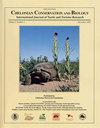Identification of Potential Sea Turtle Bycatch Hotspots Using a Spatially Explicit Approach in the Yucatan Peninsula, Mexico
IF 0.8
4区 生物学
Q3 ZOOLOGY
引用次数: 10
Abstract
Abstract A spatially explicit participatory approach was used to collect fishing effort and sea turtle bycatch data from local fishers at 15 ports in the Yucatan Peninsula, Mexico. These data were combined with satellite telemetry data to define potential bycatch hotspots. This is the first participatory and spatially explicit study on sea turtle bycatch rates in the region. Hawksbill turtles (Eretmochelys imbricata) were the most frequently caught bycatch species, followed by loggerheads (Caretta caretta) and green turtles (Chelonia mydas). Gillnets were the most dangerous for sea turtles, with the greatest incidence of dead turtles caught. Three particular bycatch hotspots were identified at the northeast, northwest, and southwest coasts of the peninsula. Identification of bycatch hotspots is recognized worldwide as a key element for protecting these endangered species, particularly in a region such as the Yucatan Peninsula that harbors critical habitats for ≥ 4 sea turtle species, 2 of them categorized as critically endangered (hawksbills and Kemp's ridleys [Lepidochelys kempii]). The spatially explicit participatory approach is versatile, easy to implement, and strategic for generating information under marine spatial planning for endangered species conservation.利用空间显式方法识别墨西哥尤卡坦半岛潜在的海龟副捕获热点
摘要采用空间明确的参与方法,从墨西哥尤卡坦半岛15个港口的当地渔民那里收集捕鱼努力和海龟副渔获物数据。这些数据与卫星遥测数据相结合,以确定潜在的副渔获物热点。这是该地区首次对海龟副渔获率进行参与性和空间明确的研究。霍克斯比龟(Eretmothelys imbrica)是最常被捕获的副渔获物物种,其次是红海龟(Caretta careta)和绿海龟(Chelonia mydas)。刺网对海龟来说是最危险的,捕获死海龟的几率最高。在半岛的东北、西北和西南海岸发现了三个特别的副渔获物热点。识别副渔获物热点是全世界公认的保护这些濒危物种的关键因素,尤其是在尤卡坦半岛等地区,该地区拥有≥ 4种海龟,其中2种被列为极度濒危物种(hawksbills和Kemp's ridleys[Lepidochellis kempii])。空间明确的参与式方法用途广泛,易于实施,具有战略意义,可用于根据海洋空间规划生成濒危物种保护信息。
本文章由计算机程序翻译,如有差异,请以英文原文为准。
求助全文
约1分钟内获得全文
求助全文
来源期刊
CiteScore
1.70
自引率
14.30%
发文量
17
审稿时长
>12 weeks
期刊介绍:
Chelonian Conservation and Biology is a biannual peer-reviewed journal of cosmopolitan and broad-based coverage of all aspects of conservation and biology of all chelonians, including freshwater turtles, marine turtles, and tortoises. Manuscripts may cover any aspects of turtle and tortoise research, with a preference for conservation or biology. Manuscripts dealing with conservation biology, systematic relationships, chelonian diversity, geographic distribution, natural history, ecology, reproduction, morphology and natural variation, population status, husbandry, community conservation initiatives, and human exploitation or conservation management issues are of special interest.

 求助内容:
求助内容: 应助结果提醒方式:
应助结果提醒方式:


